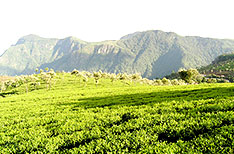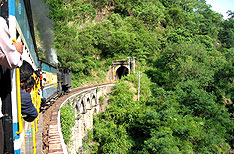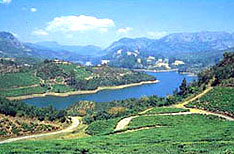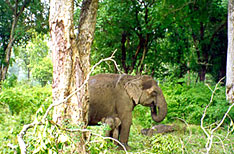 |
  Home | Contact | Site Map |

| Top Destinations |
|
You are here Home » Top Destinations » Coonoor Tamil Nadu
Honeymoon in Coonoor, Tamil Nadu, India  About Coonoor A quiet hill station, an hour away from Ooty, and reached by a delightful toy-train, Coonoor nestles snuggly in the lap of the famous blue Nilgiri hills. A delightful town with exquisite scenery all round, there is much to see at this idyllic, lesser-known retreat covered by grassy meadows, a profusion of sunflowers, marigolds and rhododendrons, all growing wild. With steep hills and valleys carpeted with tea bushes, interspersed with eucalyptus and silver oak, life moves at a gentle pace in this town of tea estates. Commanding a breathtaking view of the Coimbatore plains, it is a paradise for avid trekkers and naturalists with its vast stretches of undisturbed shoals forests. An essentially small tea garden town, the weather remains pleasantly cool throughout the year. HISTORYCoonoor is part of the magnificent Nilgiri range, so called because of the magical blue mist that hangs around the mountains. John Sullivan first discovered it for the outside world. In May 1819, Sullivan visited the eastern plateau for three weeks with a noted French naturalist, who was named somewhat pompously, Jean-Baptiste Louis Claude Theodore Leschenault de la Tour. Despite that name, he was no stranger to the ills that befell white men in the plains of India. But on reaching the hire altitudes near Coonoor, he recovered and got his strength back. Sullivan built the first stone house in Ooty. Between 1820 and 1827, he pleaded with the directors of the East India Company to develop that area in the Nilgiris as a sanatorium for sick European troops in India. When they finally capitulated, they began developing the area and also laid down the first railway lines -- which still exist as The Blue Mountain Railway thus making it easier for the ailing. But long before heat-and-dust-ravaged white men began making the pilgrimage to the hills and health, the Danayakas held the country adjoining the Coimbatore region, which included the talukas of Kotagiri and Coonoor. The Toda tribe has lived in these parts since time immemorial. Some of their ancient tribal homes can still be found on the outskirts of the region. CULTUREA Tea and Tourism Festival is held in Coonoor every winter. FOODThe food in Tamil Nadu is comparatively inexpensive and good.Tamil Nadu provides the visitor with a wide variety of delicious food both for the vegetarians as well as the non-vegetarians.Food in Tamil Nadu consists of grains, lentils, rice and vegetables. Spices are added to give a distinctive taste. Breakfast or tiffin includes idly(steamed rice cakes), dosai (a pancake made from a batter of rice) and lentils crisp fried on a pan, vada(deep fried doughnuts made from a batter of lentils), pongal (a mish mash of rice and lentils boiled together and seasoned with ghee, cashew nuts, pepper and cummin seed), uppuma(cooked semolina seasoned in oil with mustard, pepper, cummin seed and dry lentils.) There are several variations of the dishes mentioned above which are eaten with coconut chutney, sambar (seasoned lentil broth) and mulaga podi (a powdered mix of several dried lentils eaten with oil). Lunch or meals consists of cooked rice served with an array of vegetable dishes, sambar, chutneys, rasam (a hot broth made with tamarind juice and pepper) and curd(yogurt). For a non-vegetarian lunch, curries or dishes cooked with mutton, chicken or fish is included. The meals is incomplete without crisp papads or appalam. Chettinad cuisine is a speciality in Tamil Nadu and will be a delight for those who like hot and spicy non-vegetarian food. This type of food has several variations of fish, mutton, and chicken dishes of which the Chettinad Pepper Chicken is a speciality. The Tamil style of Mughali food can be savoured in the biriyanis and paya. The later is a kind of spiced trotters broth and is eaten with either parathas or appam. Tamil Nadu, especially Chennai, is famous for its filter coffee as most Tamils have a subtle contempt for instant coffee. The making of filter coffee is almost a ritual, for the coffee beans have to be first roasted and then ground. The powder is put into a filter set and boiling hot water is added to prepare the decoction and allowed to set for about 15 minutes. The decoction is then added to milk with sugar to taste. The final drink is poured from one container to another in rapid succession to make the ideal frothy cup of filter coffee. The last process makes one wonder whether the brew could be bought by the yard. SHOPPINGHoliday without a shopping spree is certainly not complete. So while holidaying in the hill resort of Coonoor you must pick up the South Indian artifacts. There are several renowned shops in Coonoor from where you may buy the artifacts. These Artifacts make excellent purchases as gift items and souvenirs from Coonoor. ENTERTAINMENTThe hill resort of Coonoor hosts several interesting festivals. Firstly there is the annual fruit and vegetable festival that is hosted at the Sim's Park. Tourists from across the globe get attracted to the festival organized in May each year. Then there is the tea and tourism festival hosted in Coonoor. The annual festival attracts tea connoisseurs from the world over in January at Coonoor. It is noteworthy that the hill resort of Coonoor lies in the Nilgiri Mountains that are renowned for tea plantations. Some of the better-known tea brands from Coonoor are the Orthodox, CTC and Green Leaf. General Information of Coonoor LOCATIONCoonoor, in Tamil Nadu, is the second-largest hill station in the Nilgiri Hills, which is at the confluence of three of the four southern states of India Tamil Nadu, Kerala and Karnataka, in the Western Ghats. How to Reach By AirThe nearest airport is Coimbatore (2 hrs from Coonoor). Indian Airlines has a daily connection between New Delhi and Coimbatore. Coimbatore also has daily flights to and from Chennai, Bangalore, Kochi and Thiruvananthapuram. By RailKerala Express leaves New Delhi Raliway Station at 11.30 am and arrives at Coimbatore the next day at 5.40 am. (2-tier AC ? Rs 2,440/ 3-tier AC ? Rs 1,600).A toy train connects Coonoor with Mettupalayam (28 km) and Ooty (18 km). Running at a maximum speed of 33 km/ hr, this train provides some breathtaking views of the Nilgiri Hills. It leaves Mettupalayam for Ootacamund (Ooty) at 7.45 am and arrives in Ooty noon. However, this train service is often disrupted during heavy monsoons. By RoadCoonoor is also well connected bus with Ooty, Bangalore, Coimbatore, and Kotagiri. Coimbatore?Ooty regular bus service. A more comfortable and faster option would be to hire a private cab from Coimbatore to Coonoor. CLIMATEThe Tryst enjoys a very clement climate of 9 to 23 degrees C through the year. Summers (April?June) are mild, while winters (November?February) are cool, though winter nights can get a bit chilly. Rainy season Oct to mid-Dec. Tourist Attractions in Coonoor Dolphins Nose  A little further along the same road to Lambs Rock is Dolphins Nose. The Nose is a unique rock of tremendous proportions, jutting out of the face of the hillside in formation, by which its name is suggested. Commanding an excellent view of the magnificent St. Catherine's Falls with their stream continuing several hundreds of feet below, it well pays the exertion of getting there. Mudumalai Wildlife Sanctuary
Others KATTERY FALLS - About 5 Km from Coonoor on the Kendala road, one can have a wonderful view of the magnificent Kattery Falls. It is one of the highest falls in the Nilgiris to be seen and enjoyed. LADY CANNINGS SEAT - About 3 Km further along the main road is Lady Canings Seat. Charlotte Canning, wife of Lord Canning - the Viceroy, loved to sit here and paint the wonderful scenery all around. From this point, the Lambs Rock, the Droog and the Lamptons Peak are all to be seen. LAMBS ROCK - A favorite spot for public parties, Lambs Rock is a sheer precipice of jogged rock which drops down several hundred feet to bury away itself in the luxuriant jungle below. It is indeed a spot that a visitor will remember and relish for a long time. LAWS FALLS - Named after Lt. Colonel Law, who traced and mainly constructed the Coonoor Ghat, the Falls are about 5 Km below Coonoor on Mettupalayam road. One of the prettiest spot, it is famous as a place for picnics. PASTEUR INSTITUTE - Just across the main gate of Sims Park, the Pasteur Institute, is an oblong two-storied structure, with turrets at each corner and presents a solid and rather imposing appearance. POMOLOGICAL STATION - Close to Sims Park, this garden was established in 1920 with a view to demonstrate and propagate scientific methods of raising nursery plants and of growing fruit-bearing trees. RALLIA DAM - Located near Banthomai village on the Kotagiri road, Rallia Dam is the source of water supply to Coonoor town. A fine picnic spot, but of late, because of silting, the dams capacity is considerably reduced. SIMS PARK - Inaugurated in 1874, the Park occupies the slopes and base of a small ravine. At the head of the gardens, the well-kept lawns and artistically laid-out ornamental beds look beautiful and lack no wealth of the flowering plants or shrub. THE DROOG - Also known as Pakkasuran Kottai because of the dilapidated fort, it was built in the 16 century and is said that Tipu Sultan used it as an outpost. The peak here stands at an elevation of 6,000 feet and directly overlooks the plains. WELLINGTON - It is a cantonment named in honor of the Iron Duke Wellington, who took an interest in the establishment of this station as a sanitarium. |
 Lying in the Nilgiris District, it is situated at an elevation of 1000 meters. A variety of habitats, ranging from tropical evergreen forest, moist deciduous forest, moist teak forest, dry teak forest, secondary grasslands and swamps are found here. The wildlife includes elephant, gaur, tiger, panther, sambar, spotted deer, barking deer, wild boar, and porcupine etc. The avifauna is varied with minivets, hornbills, fairy blue birds, jungle fowls etc. Python, monitor lizard, and flying lizard etc represent the reptilians. Picturesque scenic spots in the sanctuary include the Moyar Waterfalls, the Chief Ministers watch tower, Ombetta Swamp, Theppakad elephant camp etc.
Lying in the Nilgiris District, it is situated at an elevation of 1000 meters. A variety of habitats, ranging from tropical evergreen forest, moist deciduous forest, moist teak forest, dry teak forest, secondary grasslands and swamps are found here. The wildlife includes elephant, gaur, tiger, panther, sambar, spotted deer, barking deer, wild boar, and porcupine etc. The avifauna is varied with minivets, hornbills, fairy blue birds, jungle fowls etc. Python, monitor lizard, and flying lizard etc represent the reptilians. Picturesque scenic spots in the sanctuary include the Moyar Waterfalls, the Chief Ministers watch tower, Ombetta Swamp, Theppakad elephant camp etc.